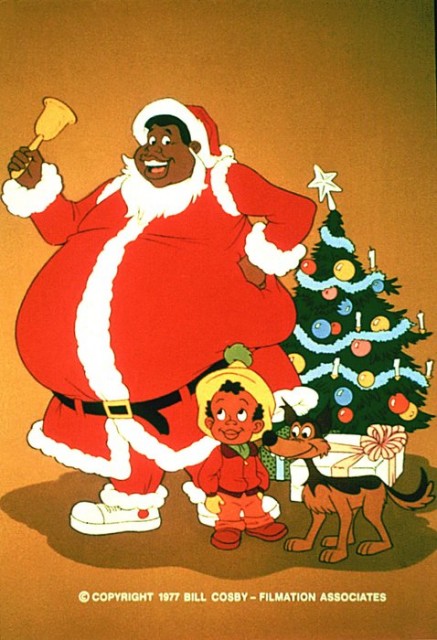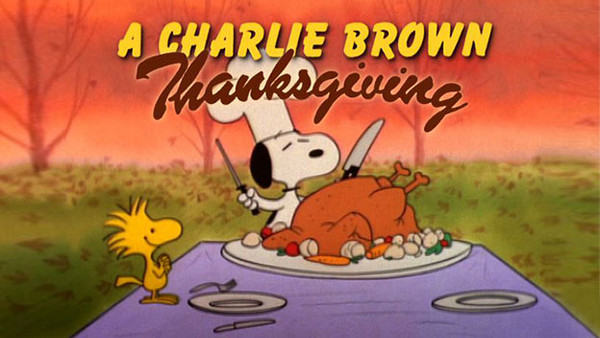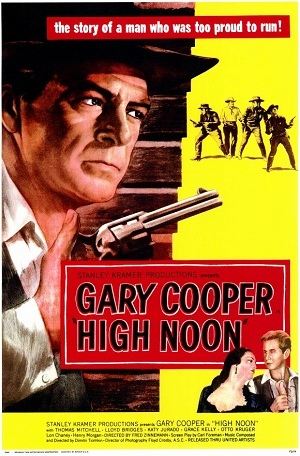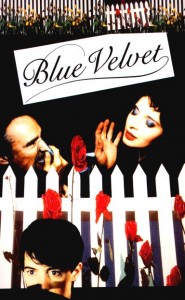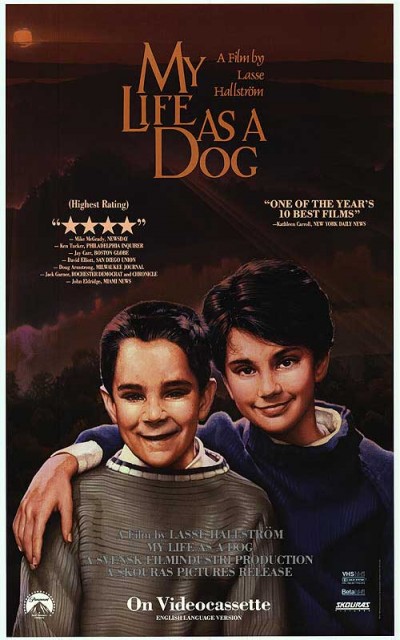Tag Archives: movies in bed
Movies in Bed: Fat Albert’s Christmas
Post by Josh Zinn.
Hello dear readers! Here we are again with another live-blog of a festive holiday special. Touching, topical, and tear-jerking, (at least I think it’s supposed to be) “Fat Albert’s Christmas Special” is here to teach us all the true meaning of the Christmas. Let’s begin!
0:01 – A luminous, star shines above the ghetto, inspiring all to raise up their… Oh, wait. It’s just the star on a Christmas tree. Silly me. Anyhow, we are now panning across a dilapidated cartoon landscape, witnessing the effects poverty has wrought upon a snow-covered, pudding pop-less world. FUN!
1:04 – Fat Albert is worried, folks. He needs to, “get this nativity scene down cold.” Words I never thought I’d ever write… Apparently, the Christmas pageant is in need of the tightest, most funkdafied manger you have ever seen.
1:25 – This cartoon has a laugh track. Glad to know half my work here is already done.
1:35 – Now the whole gang is getting into costume. So much zaniness abounds! A Christmas angel in high-tops? A wise man in a muumuu? What’ll they think of next!?
3:00 – Uh oh, a grumpy old man with a cane is at the clubhouse door! Looks like someone is in need of some holiday cheer and a tired, clichéd story arc involving redemption of the soul. Ho ho ho.
4:19 – Jeez, now there’s a kid at the door, suffering from the sniffles, clothes with too many earth tones, and a society that refuses to acknowledge the plight of the lower class. He’s whining cause his parents’ car is broken down, his mother is pregnant, and… oh… I’m seeing where this plotline is going.
6:52 – Remember that old man? He wants to destroy the clubhouse! Fat Albert is trying to explain that the clubhouse is necessary because, at the moment, a pregnant woman resides within. Seriously? She has NOWHERE else to go? I mean, I get what the whole point of this in the context of teaching Christmas lessons, but that’s not really a valid argument unless Mushmouth happens to be a midwife.
8:30 – The pregnant woman’s family is at the hospital, finding themselves rejected by the cold finger of bureaucracy. If they had done their research, they would know that all thinly-veiled-metaphors-for-the-birth-of-the-savior pregnancies are handled by the city hospital.
10:38 – Albert’s in a Santa suit, working for the old man’s discount store. His friends are accusing him of selling out, but in reality he is sneakily being taken advantage of by a grieving widower who has lost his ability to relate to a world that chooses to celebrate life rather than wallow in the pain of death. Will he ever learn THE TRUE MEANING OF CHRISTMAS? There’s some seriously deep circle of life stuff happening here, folks.
14:05 – The little sniffle kid is out at night. Alone. In the ghetto. Perhaps this would be a good reminder for his parents to focus on, y’know, the child they already have. Never fear, however, because—as is common in the vernacular of the under-six set—he exclaims, “Don’t worry Mom and Dad. I’m cutting out.”
15:16 – Albert has just asked the visibly pregnant woman without a baby whether or not she has had said baby yet. Methinks it’s time to start collecting pudding pop box tops for education.
16:04 – So, the father has just realized Sniffles is missing. He reacts by opening up the clubhouse door, taking a gander at the dangerous urban blight his son is lost in, and then closing the door with nary a word. At this point, even I’m ready to call Child Protective Services.
17:54 – Fat Albert and friends have taken it upon themselves to search for Sniffles. Fearing for his life (would you want to be returned to such neglectful guardians?) he chooses to run onto an icy river in an attempt at recreating Virginia Woolf’s final moments.
18:55 – The gang returns to the clubhouse, Sniffles-less. The baby is born, everyone is smiling, and no one seems to care anymore that the other kid is missing. Out with the old, in with the… Who’s at the door??
19:25 – The old man back! And he has Sniffles! Thank the lord, another child has not been lost emulating the tragic death of a famous literary figure!
20:30 – Realizing the potential PR nightmare he has on his hands, the old man decides to spare the clubhouse! Hooray! Now everyone is giving one another gifts that have materialized out of thin air. Following suit, the old man reaches in his pocket, pulls out a baseball (he obviously does not wear skinny jeans), and gives it to Sniffles.
21:45 – Yearning for validation of this good deed from his dead wife, the old man looks upward towards the heavens, asking, “How am I doing, Martha?”
21:50 – In response, the credits begin.
And that’s the end, folks! What did YOU learn about Christmas? Did you get it down cold?
Movies in Bed: Live Blogging Charlie Brown
Post by Josh Zinn.
Happy Day-After-Thanksgiving, dear readers! Instead of a normal review, we have brought you a live-blog of the holiday favorite, “A Charlie Brown Thanksgiving.” Enjoy!
0:05 – Okay, here we go. Lucy is questioning Charlie Brown’s masculinity via a game of football. Equating the kicking of the pigskin with the thanks we give as a nation, she clearly understands how insecurity and patriotism go hand in hand.
2:02 – “What did you expect? A turkey card?” Sally Brown delving into surrealism as she ponders the US Mail System. All these kids seem so troubled by holidays. Oh jeez, here comes Linus to ruin everyone’s fun by explaining what Thanksgiving is really about. Blah, blah, blippity bloo.
3:45 – Rosie O’Donnell calls Charlie Brown, pretending to be someone named Peppermint Patty. She invites herself over for Thanksgiving. She keeps calling him Chuck and demands he save her the drumstick and the neck. Fans of Rosie will remember her predilection for turkey necks, so this should come as no surprise…
6:00 – Chuck’s having a meltdown. Now he has a bunch of kids coming over for dinner and he’s going to his Grammy’s house. Of course! Let’s just have two dinners and ask the dog to cook!!
7:10 – Some god awful jazz music is playing whilst Snoopy and Woodstock prep ping-pong tables for the big event. It’s pre-Sandra Lee tablescaping on a budget! “Little Birrrrdy….” Seriously, this song is filler. Snoopy is caught between said ping-pong tables, yet emerges triumphant. Alas, now the Adirondack chair is now assaulting him. That’s life.
10:15 – Rosie and her friends (including that poor girl Marci, who wear glasses yet has no pupils) have taken it upon themselves to decide that this Thanksgiving should be contempo-casual. “You can come as you are,” she proclaims while Kurt Cobain shudders from the heavens.
11:00 – Snoopy is cooking! Toast is toasting. Butter is buttering. Popcorn is popcorning. This is a very carb-heavy Thanksgiving; I suggest some Activia for dessert. Does anyone find it gruesome that a bird is helping to cook this feast?
13:10 – Snoopy and Woodstock are now dressing up as Pilgrims, cause Snoopy, y’know, just had that outfit lying around. What if someone dressed up as Snoopy and then dressed up as a pilgrim as well? Thankful Furrying? Charlie Brown does the right thing and puts that dog in a chef’s hat.
15:13 – Ding Dong! Rosie’s here
15:35 – Everyone is seated. Outside. In November. I never knew Peanuts took place in Palm Beach.
16:00 – Oh god, Linus is explain Thanksgiving AGAIN. Give it a rest kid. No one likes someone being the moral compass at every party. At least he’s surrounded by what look like raspberry parfaits.
17:20 – Rosie is flipping her lid. Jellybeans? Popcorn? Obviously the woman is open-minded because she seems not to mind a dog serving her. Let it be known, though, never give Rosie O’Donnell a pretzel stick or she’ll ream you. Rude.
17:35 – Shot of Sally eating. She’s useless.
18:25 – It takes a girl without eyes to muster up the courage to put Rosie in her place. There’s a parable there, I think. Now she’s asking Marci to hit on Charlie Brown for her. This cartoon is very unrealistic.
19:10 – Linus is bringing up Myles Standish AGAIN. Stand down, blanket boy!
20:13 – Rosie apologizes and asks not to play, “lovers games.” Again, unrealistic.
21:20 – Chuck’s talking to Grams on the phone and she sounds like she’s chewing on a mouthful of squirrels. She invites everyone to come to her condo for Thanksgiving dinner. Oh, that’s right. Palm Beach.
21:45 – They all leave Snoopy behind so that he and Woodstock can eat a turkey dinner Snoopy’s been hoarding in his doghouse. Again, Woodstock, a little bird, is eating a turkey. This seems very wrong.
22:00 – And it’s all over and what we’re left with are the credits and Snoopy gorging himself on pumpkin pie and guilt. Blame it on Rosie.
Movies in Bed: Film Studies 101 High Noon
Post by Josh Zinn.
Retired Marshal Will Kane has a problem. Having made a name and reputation for himself as man whom the residents the town of Hadleyville depended upon to establish a peaceful, orderly community, he now finds himself, in a time of personal crisis, essentially ex-communicated from those whose safety he fought so diligently to ensure. Reduced to pleading with longtime friends, forced to defend his recent marriage to a Quaker woman in front of the church, and betrayed by his own deputy, Kane is left humiliated, abandoned, and defenseless by the men and women whose lives he had once sworn to protect. Like a respected employee whose work history and job security are eventually trumped by a company’s bottom line, Kane’s legacy is simply not enough for those whom he served to place their well being on the chopping block along with his. A victim of the very placidity he helped engender, Kane is now a lone man amongst “friends.”
It is within this setting devoid of loyalty and camaraderie that “High Noon,” a classic of its genre, establishes itself as an example of an anti-Western. Rather than feeding into the mythos of larger-than-life men and a “rootin-tootin” landscape popularized in Westerns before it, “High Noon” claims its concerns with the ways in which members of a community might actually respond to one another in light of a larger threat. Instead of guns a’blazing and horses grazing, the town reacts to the impending arrival of Kane’s nemesis, outlaw Frank Miller, by shuttering their windows and closing themselves off from having anything to do with the well-being of one another. Whether this is done out of fear, greed, or in the name of the community’s “best interest,” the eventual outcome is the same: In Hadleyville, it’s every man for himself, regardless of whether someone gets hurt along the way.
This depiction of deceit and disloyalty, while cynical in comparison to other films in its genre, may also be seen as a response to the political climate of the time in which it was made. While comparisons to anti-communist blacklisting efforts (with film community members being forced to turn upon one another in hopes of saving themselves) of the time are certainly warranted, what continues to make High Noon relevant is its unflinching examination of what might lay behind the façade of American idealism. Rather than simply celebrating the pioneering spirit of people who dared to stake claim on a new life for themselves, the film makes the case that, in fact, this entrepreneurial spirit also allows our values and sense of community to take a backseat to doing what needs to be done in order to ensure our own personal success. Since the security of Will Kane’s life rests, in part, on the ability of those around him to stand up for him, it becomes apparent—through the townsfolk’s inaction—the American dream is not collective, but rather a collection of individual desires far less altruistic than it pretends to be.
While some may claim that, like Marshal Kane, they too possess the content of character that would stand up to seemingly insurmountable odds in support of another, the truth of the matter is that human nature often turns a blind eye to problems that are not our own, hoping they will eventually go away. Because Kane had done so much good for his community, he believed his community would respond in kind when he needed help the most. Unfortunately, he is to learn that that train has long since left the station.
Movies in Bed: Blue Velvet
Post by Josh Zinn.
A code of conduct listed in the Disneyland new employee manual states, “All cast members must appear calm, content, and capable while working. At Disneyland a pleasant smile is a personality trademark that we use all the time in greeting, directing, and making our guests feel comfortable. You don’t have to laugh, just smile. Don’t be a Gloomy Gus or a Grouchy Gertrude.”
During the opening minutes of David Lynch’s “Blue Velvet,” the town of Lumberton appears to be an idyllic place, the kind of community where even Grouchy Gertrude’s cannot resist a grin or two. As hyper-saturated flowers sprout through the ground, children excitedly scurry to school, and fire trucks cut through the dewy morning haze, all seems right with the world. Like a neighborhood that has emerged from some promise of sanctity made by “Ozzie and Harriet” and “The Donna Reed Show,” the artifice of its mise-en-scene is intoxicating and familiar not because it resembles the world we live in—or even necessarily desire to—but because it is a portrait of what we’ve been told our lives should aspire to be.
Underneath its façade, however, not everything is so squeaky-clean. As the opening sequence continues, Lynch introduces elements of the grotesque amidst this artificial environment. A gun appears briefly on a television; a man collapses while watering his lawn; and, as the camera moves past his still body, cutting through the grass, an underworld of insects is discovered writhing beneath the blades. Presumably they have always been there, but like so many things eventually uncovered in this town, their existence has been buried under the layers of innocence, tranquility, and self-imposed naiveté Lumberton’s reputation is built upon.
This duality in reality, of experiencing and acknowledging the darkness that thrives beneath the manufactured gloss of our clichéd suburban ideals, is the heart of “Blue Velvet’s” story. Because Lynch’s introduction of Lumberton in this sequence is so steeped in the kind of Americana nostalgia where every shot is bathed in filtered light and moves in slow motion, the impression given is that it exists outside of reality, in a realm where Dalmatians really do ride in fire trucks. Neither dream nor truth, the perfection Lumberton appears to exhibit may be seen, then, as the culmination of good intentions and sheer will triumphing over desire and emotion. Like a rehabilitated drug addict, the town is “good” so long as it is able to maintain its behavior. Beneath its fragile exterior, however, its demons continue to look for ways to claw themselves free.
Because “Blue Velvet’s” story descends into what may be construed as the underbelly of Lumberton, it becomes apparent that Lynch is both examining and satirizing peoples’ need to keep up appearances. Quickly exposing both the audience and his characters to the cracks that have begun to riddle the artificial, too-good-to-be-true foundations of the town, Lynch injects the film with a freedom to be unreliable in its depiction of truth. Here, regardless of what may appear to be a meticulously created reality, other forces are always at work shaping the landscape. One simply needs to keep their ear (sliced off or not) to the ground to listen for them.
Like Disneyland, a smile may go a long way in Lumberton, but that doesn’t necessarily mean everything is okay.
Movies in Bed: My Life as a Dog
Post by Josh Zinn.
The boy has no real home, not anymore. Orbiting around the lives of those for whom he feels his existence is now, in one way or another, a complication, his time is spent comparing what he endures with the lot of those whose circumstances appear to have been far worse than his own. It’s a way to get by in this transient life, when you’re viewed more as an attachment, a burden, a nuisance, a pet, than as someone worth knowing. “At least we’re not them,” we tell ourselves, all the while knowing we probably wouldn’t spend so much time thinking about it unless some of their pain resonated with our own.
Lasse Hallström’s “My Life as a Dog” knows what it’s like to feel forgotten about and left to drift towards some unknown oblivion. Like so many of the stories that flow through his mind, the film’s protagonist, Ingemar, is a boy whose happiness and well-being has become an after-thought. Seemingly unwanted, he lives on the outskirts of life, confined to adjunct spaces, with the rest of the world now existing behind shut doors or in memories of better times with his mother. Like Laika, the first dog in space whose fate is ruminated over throughout the film, Ingemar’s idea of his future appears isolated, grim, and hopeless.
To portray this notion of Ingemar being removed from the rest of the world, Hallström places the boy in a series of confined spaces throughout the film. From a drainage tunnel under train tracks, to the cabinet he hides under when his Mother is taken away, to the small spaceship-shaped “funhouse” he hides away in, Ingemar is put in places where he won’t be in the way. Unaware of the complexities of life taking place around him and confused about the changes happening within his own body, Ingemar is frequently trapped within his thoughts, unable to explain or understand what he is feeling. These pockets of solitude, then, become a representation of the darkness—the naiveté—that he must emerge from if he is to find his place in the world.
These allusions to space and rebirth also play a more obvious role in the two attempts Ingemar and his friends make to jettison a makeshift “spacecraft” they find in the old barn. Their first attempt, made when Ingemar is still stuck and holding back from embracing his new surroundings, comes to a halt in mid-air, literally leaving its crew hanging. The second attempt, coming at the end of the film—following a climactic breaking down of the fun house door and Ingemar’s subsequent exorcism of grief and guilt—successfully flies but, even more importantly, comes crashing back down to earth and into a puddle of cow manure. Now knowing he is no longer destined to float away into the ether, Ingemar learns that living an engaged life often means dealing with the crap you’re bound to find yourself in from time to time.

